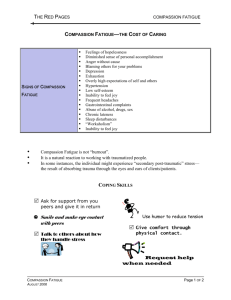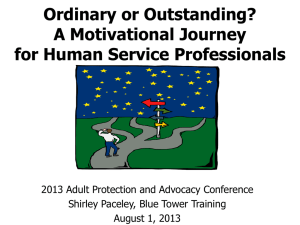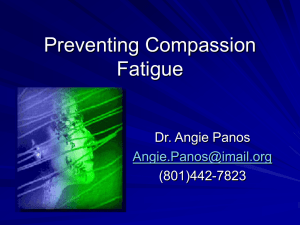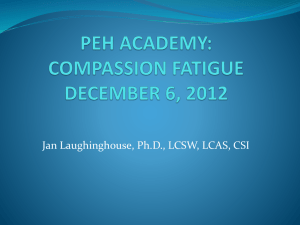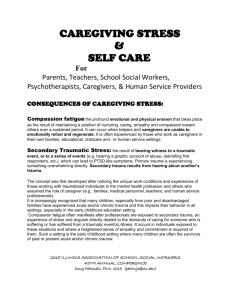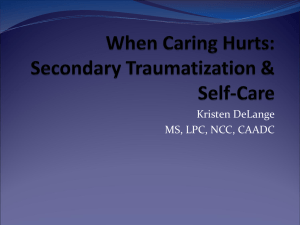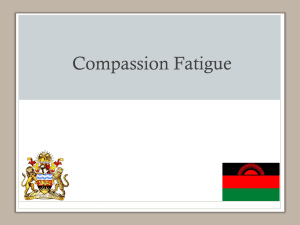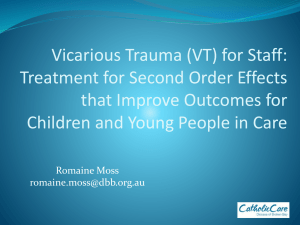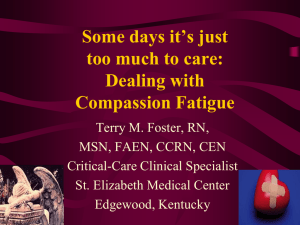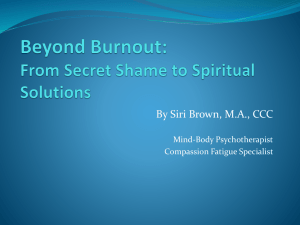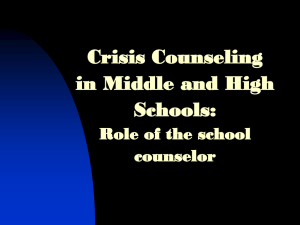Compassion Fatigue: When Helpers Get Tired of Helping
advertisement
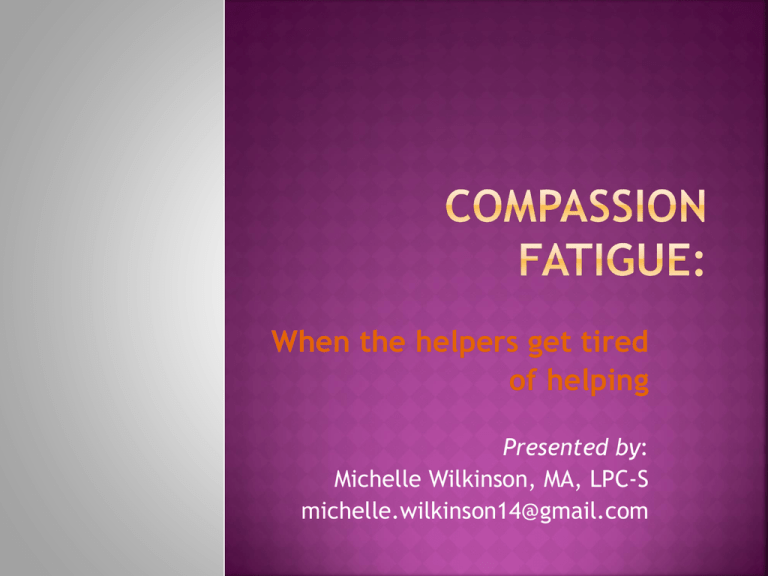
When the helpers get tired of helping Presented by: Michelle Wilkinson, MA, LPC-S michelle.wilkinson14@gmail.com Definition of Compassion Fatigue Identify the Signs and Symptoms Tools to recovery Observing the signs in self and others Prevention Definition: World English Dictionary compassion fatigue — n the inability to react sympathetically to a crisis, disaster, etc, because of overexposure to previous crises, disasters, etc Compassion Fatigue was first introduced by Carla Joinson in 1992, as a way to describe burnout among nurses Maslach and her colleague Jackson first identified the construct "burnout" in the 1970s,the term was coined by Herbert Freudenberger in1974 McCann and Pearlman use the term Vicarious Traumatization in 1990 Empathy Fatigue Burnout Vicarious Traumatization Secondary Traumatic Stress Disorder Just plain sick ‘N’ tired 76% of 2,500 clergy members survey were overweight or obese compared with 60% in general population More than 60% of helping professionals have a trauma history of their own—we enter the field to make a difference, to give back, and share from our own life experiences 59% of mental health professionals were willing to seek help vs 15% of law enforcement Burnout---is a term that describes low job satisfaction, feeling powerless, overwhelmed, depleted and frustrated by their work environment Many persons in ‘non-helping’ jobs may experience burnout, who are not particularly in a traumatic environment Employees who considered most of their days to be quite a bit or extremely stressful were over three times more likely to suffer a major depressive episode, compared with those who reported low levels of general stress Chronic Compassion Fatigue can lead to depression, anxiety, addiction, mental and physical illnesses if left unchecked Vicarious Traumatization, a termed coined by Laurie Ann Pearlman and Karen Saakvitne, is used to describe the profound shift that workers experience in their world view when they work with clients who have experienced trauma Helpers notice that the way they think about clients and the world, is somehow changed by the cumulative process of repeated exposure. Primary Trauma refers to trauma that is happening to you, either from your personal life or even in the line of duty Secondary Trauma is the exposure to trauma via retelling of stories by client or co-worker, reading case files, hearing court testimonies or watching disturbing news footage Sleep Disturbance Exhaustion Avoidance of circumstances Isolation Self-doubt of ability to help Stress Complacency Secretly wishing clients don’t show up! Anxiety Irritability Resentments with co-workers Missing meetings or peer supersvions OVERWORKING This is not an exhaustive list………… “My biggest challenge as a director is that I am trying to do the work of two people. When I moved into this position, I replaced a full-time counselor. I also replaced one of the pastors who had functions as part-time overseer for the counseling center. My position as director should be a full-time position, it is impossible for me to successfully handle the responsibilities of both positions and to them both well” Director of a women’s counseling center Compassion fatigue has been described as “the cost of caring” for others in emotional pain Compassion fatigue is an occupational hazard Compassion Fatigue is a disorder that affects those who do their work well Caring for others is both my calling and my cross to bear Decline in health, relationship and Job Performance Thoughts of quitting! Feelings of Fear, Anxiety, and Inadequacy Low self-esteem and lack of confidence OVERWHELMED STRESSED OUT DEPRESSION FRUSTRATION Self Test Self Care Self Worth •Are you in the danger zone? •Professional Quality of Life test •Compassion Self-Test •Limiting exposure •Setting Boundaries •Be confident •Take your own advice! Prevention is ideal, but may not be realistic Know your own patterns Be confident, you got this! Find the ‘off switch’ in your head, and by all means shut it down when you leave the office Be human, respect your emotional limits Their emergency is not necessarily your emergency! Give yourself some grace! Community and Professional resources Compassion Fatigue Awareness Project/Healthy Caregiving, LLC The Compassion Fatigue Awareness Project (www.compassionfatigue.org) promotes an awareness and understanding of Compassion Fatigue and its effect on caregivers. Beth Hudnall Stamm ProQOL Institute The Green Cross Who’s job is it to help protect the helpers? Create an atmosphere of peace Surround yourself with encouragement Regain your smile Notice a Sunrise or Sunset Be Still Journal Take a “Mental Break” Day! Massage Exercise Meditation Be a client Support Groups Professional Education As counselors and caring professionals we give of our time, our talent and our treasure. You can’t give all of your treasure away Self-care is a lifelong journey and a consciously chosen lifestyle. Save some good things for yourself “there is no such thing as a normal life, just life”—Wyatt Erp Keep living, giving, and caring! American Psychological Association (APA): compassion fatigue. (n.d.). Collins English Dictionary - Complete & Unabridged 10th Edition. Retrieved January 23, 2013, from Dictionary.com website: http://dictionary.reference.com/browse/compassion fatigue The Compassion Fatigue Project Copyright 2008-2013. ProQOL.org © January 2013 Counseling Today | “Who’s taking care of Superman?” Powered by WordPress . Definition: Vicarious Traumatization—Laurie Ann Pearlman and Karen Saakvitne Ferguson, S. (2007)Clergy compassion fatigue. Family Therapy Mag. Mar-April issue The Compassion Fatigue Workbook: Creative tools for transforming compassion fatigue and vicarious traumatization
